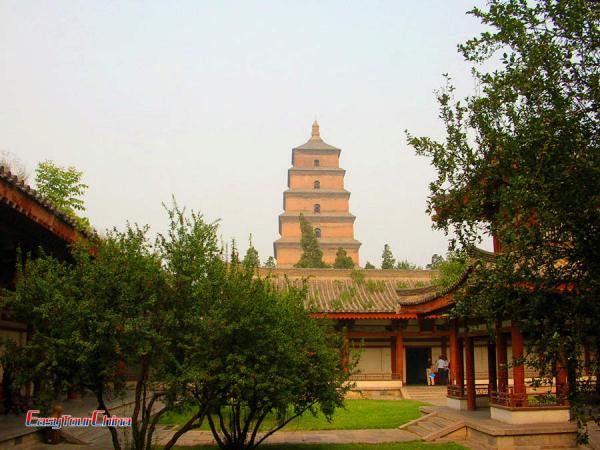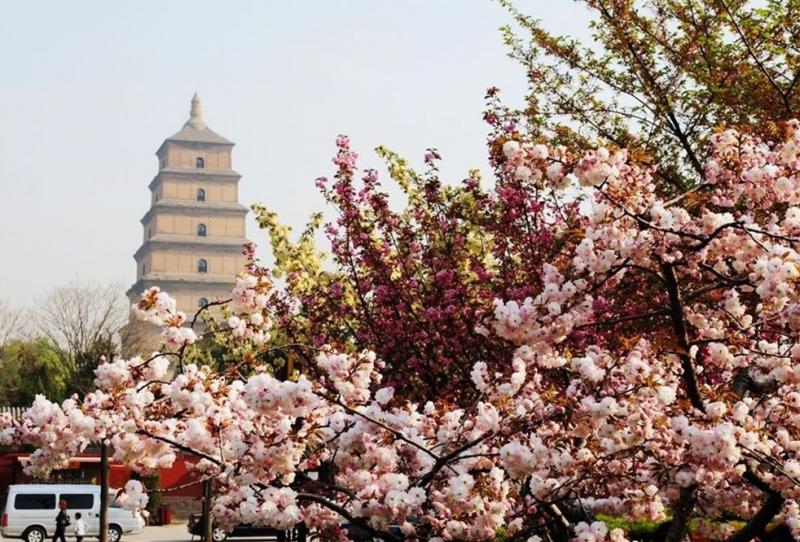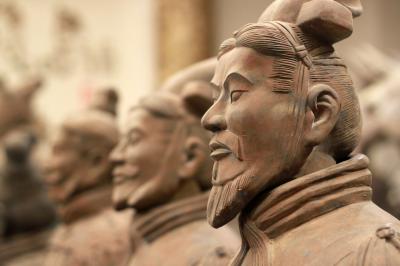Big Wild Goose Pagoda (Dayanta) and Da Ci'en Temple
Big Wild Goose Pagoda (Dayanta) is located in the Da Ci'en Temple in Jinchangfang, Xi'an, so it is also known as the "Ci'en Temple Pagoda". It was built by monk Xuanzang for collecting precious Buddhist scriptures that he carried from Tienjiku, ancient India, in Tang dynasty when Buddhism is very popular.
There are 7 floors with 64.5m for the main building of the pagoda, making it the tallest building at that time. It is a square-brick tower in pavilion type, by tower base, tower body, tower top composition. From the top of the Giant Wild Goose Pagoda, you can see the beauty of the whole Chang'an (ancient name of Xi’an).
Now, it’s not just a valuable historical relic for studying Empire Tang’s history and Buddism, but a representative ancient Chinese architecture in Xi’an city. As the earliest and largest surviving Tang Dynasty square-pavilion brick pagoda, Big Wild Goose Pagoda bears witness to the introduction of the ancient Indian Buddhist temple architectural form into Chinese culture along with Buddhism, as well as the cultural exchange between East and West during the heyday of the Silk Road. In 2014, Giant Wild Goose Pagoda was inscribed on the UNESCO World Heritage List as a Silk Road site.
Xian Giant Wild Goose Pagoda Facts

History of Big Wild Goose Pagoda: Why It was Built
Situated in 4 kilometers south of Xi'an City, it is one of the famous Buddhist pagodas in China. During the reign of Emperor Daowu of the Northern Wei Dynasty, Jingjue Temple was constructed here. Emperor Wen of the Sui Dynasty later built Wulou Temple on the site of Jingjue Temple, which was later abandoned.
In the 22nd year of the Zhenguan era of the Tang Dynasty (648 AD), Crown Prince Li Zhi, wishing to commemorate his birth mother Empress Wende (née Changsun) and pray for her eternal peace to repay her maternal kindness, petitioned Emperor Taizong to decree the construction of a Buddhist temple, bestowing upon it the name “Ci'en Temple.” Upon its completion, the temple invited the eminent monk Xuanzang to serve as its chief abbot. Xuanzang established the Mahayana Buddhist school of Yogācāra (Fa-xiang) here, transforming the temple into a sacred site of Mahayana Buddhism in China.
In the third year of the Yonghui era (652 AD), Master Xuanzang constructed a five-story brick pagoda in the western courtyard of Chang'an's Ci'en Temple to enshrine the Buddha statues, relics, and Sanskrit scriptures he had brought back from India. This pagoda is the Giant Wild Goose Pagoda. Master Xuanzang personally oversaw the construction, which took two years to complete. Unlike Famen Temple in Baoji, where the temple was built around the pagoda, the Big Wild Goose Pagoda was constructed to house the temple. The Great Ci'en Temple, where the pagoda stands, served as Xuanzang's dedicated site for translating and storing Buddhist scriptures.
The newly built pagoda was named Wild Goose Pagoda. Later, a smaller Wild Goose Pagoda was constructed within Chang'an's Jianfu Temple, leading to the Ci'en Temple pagoda being referred to as the Big Wild Goose Pagoda, while the Jianfu Temple pagoda became known as the Small Wild Goose Pagoda.
The original design of the Big Wild Goose Pagoda was modeled after India's renowned and only stupa dedicated to Buddha, the Bodh Gaya Stupa, featuring five stories and a height of 60 meters. During Empress Wu Zetian's Chang'an era (701–704), the pagoda underwent major renovations and was rebuilt into a seven-story structure. In the 32nd year of the Wanli reign of the Ming Dynasty (1604), the pagoda was repaired once more. Its exterior retains the Tang Dynasty design without alteration. Standing 64.5 meters tall and occupying an area of 2,061 square meters, this is the Giant Wild Goose Pagoda we see today.
Legends of Its Name
A legend tells that one day a group of big wild geese flew over, suddenly one of them dropped from the sky and died on the ground. Monks were at a loss and did not know what to do. They said that the dead wild goose was a Buddha. They buried the goose and a pagoda was erected, hence the name – the Big Wild Goose Pagoda. The Big Wild Goose Pagoda of Xian China is a structure of imposing grandeur.
Another legend tells, on the way to Tienjiku, monk Xuanzang was once stuck in the desert without food and water, and he was in a desperate situation at that time. When he was in this dilemma, he was guided by wild geese and finally found water to survive. After returning to Chang'an, Xuanzang prayed and expressed his gratitude by building the Big Wild Goose Pagoda in order to thank the bodhisattva for its enlightenment. And “Ci’en” is kindness in English.
Xian Giant Wild Goose Pagoda Architecture & Interior - What to See?
Xian Big Wild Goose Pagoda stands 64.7 meters tall, with a 4.2-meter-high base. Its north-south length is approximately 48.7 meters, and its east-west length is about 45.7 meters. The base of the pagoda has a square-pyramid shape with each side measuring 25.5 meters. The spire stands 4.87 meters tall. The first and second stories each contain nine rooms, the third and fourth stories have seven rooms each, while the fifth, sixth, seventh, and eighth stories each have five rooms. Then on each story you can find arched doorways on all four sides.

Underground Palace
According to historical records, in the 19th year of the Zhenguan era of the Tang Dynasty (645 AD), Xuanzang returned from India with a vast collection of Buddhist relics, over a hundred authentic palm-leaf manuscripts in Sanskrit, and eight gold and silver Buddha statues. Yet the location where these treasures were ultimately stored remains unknown.
Floor 1
It’s the south gate of pagoda. When you come into it, there are several famed tablets and steles hanging on the all. In addition, there are also descriptions of Xuanzang's life, as well as other celebrities, stories and history of the Tang dynasty. Next, on the first floor, there is also an exhibition of the common knowledge of ancient pagodas and photos of famous Chinese pagodas, showing the origin and development of pagodas, as well as the structure and classification of them.
Floor 2
The treasure of Da Ci’en Temple, the statue of Sakyamuni Buddha, is enshrined here, which attract millions of visitors worshiping. On both sides of the wall, there are also poems by famous people in the Tang dynasty.
Floor 3
In the middle of this floor, a wooden base is set laying Buddhist relics and pagoda’s model. Visitors can learn something about Buddhism.
Floor 4
Inside the forth story are two sutras about 40 centimeters long and 7 centimeters wide, inscribed in a dense Sanskrit script that is said to be known by fewer than 10 scholars around the world today.
Floor 5
A tablet of Buddha's foot with rich connotation carved by Li Tianzhao, a stonemason at the Yuhua Temple hired by Xuanzang in the late Tang dynasty. Moreover, poems of Xuanzang are collected and presented here.
Floor 6
Masterpieces of 5 famed poets (Du Fu, Cen Sen, Gao Shi, Xue Ju and Chu Guangxi) are displaying on the sixth floor. They made an appointment to ascend the Big Wild Goose Pagoda, where they drank and enjoyed the scenery, and wrote several classic poems.

Floor 7
The seventh floor is the highest point of the Giant Wild Goose Pagoda, which can view the city from all sides.
>> Recommended Xian tours to Giant Wild Goose Pagoda:
North Square of the Big Wild Goose Pagoda
Big Wild Goose Pagoda North Square begins at the southern end of Yanta Road in the north, borders the northern outer wall of Da Ci'en Temple in the south, and stretches from Guangchang East Road in the east to Guangchang West Road in the west. It measures 218 meters from east to west and 364 meters from north to south, covering an area of over 100 mu (approximately 166 acres) and boasting a construction area of approximately 110,000 square meters. The square features a water fountain, a cultural plaza, landscaped gardens, a cultural corridor, and tourist and commercial facilities.
The North Square of the Big Wild Goose Pagoda has set numerous new records. It boasts Asia's largest fountain square and largest water feature square, with a water surface area of 20,000 square meters. It is also Asia's largest sculpture square, featuring two 100-meter-long group sculptures, eight sets of large-scale figure sculptures, and 40 ground reliefs. Moreover, it houses the world's most luxurious green, contactless restrooms.
Giant Wild Goose Pagoda Music Fountain Show
It’s the most large-scaled music fountain in Asia, and seems a representative site of Big Wild Goose Pagoda. The fountain is divided into three areas: 100-meter waterfall pool, eight-level plunge pool and front-end music pool, showing spectacular performance with music, the show at night is one of the must-see highlights of here.
Timetable
Monday, Wednesday, Thursday and Friday: 12:00, 16:00, 19:00, 21:00
Weekends and public holidays: 12:00, 14:00, 16:00, 18:00, 20:00, 21:00, 21:00
Tuesday: 18:00, 20:00, 21:00
Ticket price
Free admission.
How to Get There?
You can take Metro Line 3 to Dayanta (Big Wild Goose Pagoda) Station and walk for 8 minutes to reach the scenic spot.
Bus 5, 21, 22, 27 and 41 run to East Exit of West Yanta Road; you can easily find where it is.


